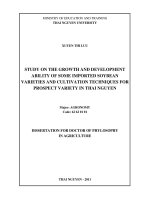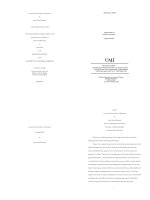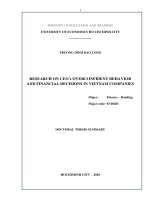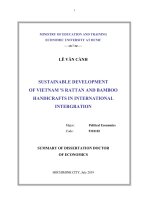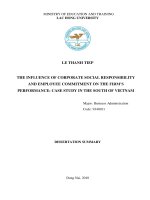Doctor of Medicine dissertation summary: Research the clinical, diagnostic imaging characteristics and evaluate the surgical outcomes of traumatic C1-C2 fracture
Bạn đang xem bản rút gọn của tài liệu. Xem và tải ngay bản đầy đủ của tài liệu tại đây (472.62 KB, 30 trang )
MINISTRY OF EDUCATION
MINISTRY OF
AND TRAINING
NATIONAL DEFENCE
MILITARY MEDICAL UNIVERSITY
KIEU VIET TRUNG
RESEARCH THE CLINICAL, DIAGNOSTIC
IMAGING CHARACTERISTICS AND
EVALUATE THE SURGICAL OUTCOMES
OF TRAUMATIC C1C2 FRACTURE
Specialty
:
Surgery
Code
:
97 20104
DOCTOR OF MEDICINE DISSERTATION SUMMARY
Hanoi 2020
THE RESEARCH WAS COMPLETED AT
THE MILITARY MEDICAL UNIVERSITY
Scientific instructor:
Associate Prof. PhD. Vu Van Hoe
Reviewer 1: Associate Prof. PhD. Nguyen Van Thach
Reviewer 2: Associate Prof. PhD. Bui Van Lenh
Reviewer 3: Associate Prof. PhD. Nguyen The Hao
The thesis will be defended before the university grade thesis
examination board in military medical university:
The thesis can be found at:
National library of Viet Nam
Library of military medical university
INTRODUCTION
Upper cervical spine injury is a very serious injury in general,
particularly in spinal injury. The mortality or severe sequelae rate
caused by cervical spine injury are very high. The upper cervical
spine including the atlas (C1) and the axis (C2) is the transition area
between the skull and the spine, which is one of the most
complicated joints in the body. At the Neurosurgery Department of
the Da Nang Hospital, we have applied this technique for 10 recent
years for unstable C1 – C2 injury treatment. Through clinical practice,
we realize that the unsolved problem in C1 – C2 fracture is a full
understanding of the injury characteristics, classification, indications
for surgery and the selection of techniques and tools for surgery as
well as bone graft. In order to make new contributions to the process
of diagnosis, selection of treatment method and plan for unstable C1 –
C2 injury, we conducted the thesis "Research the clinical, diagnostic
imaging characteristics and evaluate the surgical outcomes of
traumatic C1 – C2 fracture ” with 2 objectives:
1. Describe the clinical and diagnostic imaging characteristics of
unstable traumatic C1 C2 fracture.
2. Evaluate the surgical outcomes of C1 C2 stabilization with
screw via C1 lateral mass and C2 pedicle combined with bone
allograft.
New contributions of the thesis:
Gave the size of C1 lateral mass and C 2 pedicle, then calculated
the appropriate screws size in the C1C2 fixation surgery.
Provided the effectiveness of a surgical method and the use
of bonegraft materials which helped patients have no pain at the
bone donor site, shorter operation duration and 100% bone
healing rate.
Showed further postoperative outcomes (long time
tracking, 18 months); the VAS score, NDI and ASIA were better
than before surgery with statistical significance (11.24% compared
with 52.8%)
The thesis structure: The thesis consists of 137 pages including
45 tables, 68 pictures and 4 charts. The layout includes the
introduction (3 pages); chapter 1: Overview (35 pages); chapter 2:
patients and methods (26 pages); chapter 3: results (28 pages);
chapter 4: discussions (41 pages); conclusions (2 pages); the list of
research publishes (1 page); references (128 documents including 7
Vietnamese and 121 English documents) and appendices.
CHAPTER 1: OVERVIEW
1.1. The cervical spine anatomy
1.1.1. The bone structure
1.1.1.1. The atlas C1
The C1 vertebral has no vertebral body. It is ringlike, rugged
and consists of two large lateral masses which contain two superior
concave facets for articulation with occipital condyles and two inferior
concave facets for articulation with the axis C2. The structure of the atlas
includes anterior arch, posterior arch, lateral mass, anterior tubercle,
posterior tubercle, transverse process, transverse foramen, articular facet
with occipital condyles and articular facet with the axis. The anterior
and posterior arches are thinner to the two sides and where contact
with the lateral masses is the thinnest; therefore it is a weak position
and easy to break in trauma.
1.1.1.2. The axis C2
The axis is the thickest and strongest vertebra in the cervical
spine with a gooselike shape. The axis is easily identifiable due to its
dens (odontoid process) which extends superiorly from the anterior
portion of the vertebra. The dens is upward cylindrical, about 16.6
mm high and 9.3mm wide. The anterior facet of the dens apex
contains the facet for articulation with the concave at the posterior
facet of the atlas anterior arch and the posterior facet of dens apex
contains the facet for articulation with the transverse ligament, which
form the medial atlantoaxial joint.
1.1.2. The system of articulations and ligaments between C1 and
C2
1.1.2.1 . The medial atlantoaxial joint
Formed by the articulation of the dens of the axis with the
articular facet of the atlas.
The cruciform ligament consists of two parts: the transverse
ligament connecting the inner facet of the atlas lateral masses and the
longitudinal fibers connecting the upper edge of transverse ligament
with the occipital bone and the lower edge of transverse ligament with
the axis.
The transverse ligament of the atlas is stronger than the dens,
therefore the odontoid process is often broken before the ligament in
trauma. However, the transverse ligament is not strong enough in
some people and it is one of the pathological causes of atlantoaxial
joint instability.
1.1.2.2. The lateral atlantoaxial joints
They are plane type synovial joints which are formed by the
articulation between the superior facets of C2 and the inferior facets
of C1 The movements occur on the three articular facets
simultaneously and mostly are rotation.
1.1.3. Nerves:
The cervical spinal cord originates in the medulla oblongata and
passes through the foramen magnum. It is wider at C3 and widest at
C6 with the circumference of 38mm. The spinal cord consists of the
white and grey matter that can be distinguished on magnetic
resonance imaging. At the upper cervical spine, the spinal cord
occupies only 2/3 of the spinal canal circumference, so the nervous
clinical symptoms are very poor in trauma in spite of the spine
dislocation.
The shape of cervical spinal cord: It is divided into 2 balanced
parts by the anterior median fissure and posterior median sulcus. The
fissure is deeper and wider than the sulcus. The posterior sulcus
contains blood vessels and a fold of the pia mater.
1.1.4. The blood vessels: The vertebral artery, which originates from
the subclavian artery is the main blood supply for cervical cord. In
most cases, the vertebral artery enters the transverse foramen of C6, goes
through the transverse foramen of vertebrae along the sides of cervical
spine, bypasses the lateral mass and posterior arch of C1 and enters the
foramen magnum.
1.2. THE BIOMECHANICS OF C1 C2 STRUCTURE
The C1, C2 and occipital cranium form a complex that contains
the most complicated joints in the body because they support the
head and its movement, protect the spinal cord and other important
structures.
Most of rotation and a part of nodding and turning of the head
movements occur at the superior cervical spine (C0C1C2). The
loosening of joints allow the cervical spine to rotate nearly 50%. The
tension is enough strong to protect the delicate spinal cord structures,
blood vessels and withstand the weight of head and the force of
antagonistic muscles.
1.3. THE CLINICAL SYMPTOMS OF C1 – C2 INJURY
The clinical symptoms of C1 – C2 injury are often poor, mainly
are neck pain, stiff neck, radiating pain and numbness in the occipital
region and limited head rotation and flexion movements. Patients
with C1 – C2 trauma combined with severe spinal cord injury often
die before hospitalization because upper spinal cord trauma causes
damage to respiratory and circulatory centers in the medulla
oblongata.
1.4. IMAGING OF C1 C2 INJURY
1.4.1. Plain X ray
1.4.1.1. Conventional X ray
A standard 3view cervical spine radiography including
anteroposterior, lateral and openmouth odontoid views has a certain
value in defining the damage in the C1 C2 area.
The Spence index is calculated by the lateral overlap of the C1
lateral masses on both sides against the lateral borders of C 2,
normally less than 6.9mm. If the Spence index is > 6.9 mm, it is a
definitive diagnosis of a transverse ligament rupture and the damage
is unstable and requires surgical treatment.
The C1 – C2 dislocation was diagnosed based on the ADI index,
which was calculated by the distance between the dens and anterior
arch of C1. In general, the ADI is < 3 mm in adult and < 5 mm in
children.
1.4.1.1. Motion X ray
It is applied in chronic C1 – C2 dislocation, suspicion about
pseudarthrosis of the dens or transverse ligament rupture to evaluate
the ADI index.
1.4.2. Computed Tomography (CT scanning)
Until now, CT scanning image has been considered as the gold
standard in definitive diagnosis and classification of upper cervical
spine injuries.
* Fractures of C1: It is classified according to Levine and Edwards,
including 3 types:
Type I: Single C1 posterior arch fracture, the most common,
stable fracture, without transverse ligament damage.
Type II: Fracture of one anterior and one posterior arch
caused by a straight compressed force in tilthead position, rare
Type III: Burst fracture of C1 (Jefferson fracture), commonly
after type I fracture, caused by a straight compressed force in
intermediaryhead position, fractures of 2 points on anterior arch and
1 or 2 points on posterior arch.
* Atlantoaxial joint dislocation (C1 C2)
Definitive diagnosis of C1 – C2 dislocation, classification,
causes, MSCT reconstructs the 3D image.
* Odontoid fractures
The Anderson and D’Alonzo classification system is the most
common.
Type 1
Obliquely oriented fractures through the tip of the odontoid
Type 2
Occur through the base of the dens, where is contiguous to
the C2 body
Type 3
Fracture runs through the metaphyseal bone of the C 2 body
and fracture through the body of the axis.
1.4.3. Magnetic Resonance Imaging
It is applied in C1 fractures to evaluate the transverse ligament
damage. A high signal indicates an edema in bone marrow and
anterior soft tissues. In addition, MRI also evaluates the state of
spinal cord contusion, bleeding and edema in anterior C 1 body soft
tissues.
1.5.2. Posterior surgery for upper cervical spine injuries
1.5.2.1. Posterior C1 C2 laminar wiring techniques
Gallie technique: The use of posterior cervical wiring of
the lamina of C1 and C2 was first described by Gallie in 1939. He
used steel wire to twist the posterior arch of C 1 and the spinous
process of C2 and a homobone graft between C1 and C2.
Brooks – Jenkins technique: Brooks and Jenkins offered
an alternative method of posterior C 1 – C2 laminar wiring in 1978,
two separate autologous bone pieces were wedged in between the
C1 and C2 on both sides of the midline and wrapped the posterior
arches of the C1 and C2.
Sonntag technique: Dickman C.A. et al described the
technique of Sonntag in the 1990s. Sonntag modified the Gallie
technique to improve the rotational stability.
1.5.2.2. Posterior C1 C2 transarticular screw technique
In 1979, Magerl described the technique for the treatment of
C1 – C2 dislocation and odontoid fractures.
1.5.2.3. Occipitalcervical fusion
The occipitocervical fusion was described in the last 40
years, firstly used a bonegraft and posterior occipitocervical area
wiring. Newman and Sweetnam (1969) placed the bonegraft at the
occipitocervical junction .
1.5.2.4. The C1 lateral mass screw with C2 pedicle surgery (Harms
technique).
The C1 lateral mass screw with C2 pedicle screw construct in
the treatment for type 2 odontoid fracture was described by Goel and
Laheri in 1994. In 2001, Harms and Melcher reported 37 patients who
were applied this technique using polyaxial screw and rod.
Screw C1 through the posterior arch: was proposed by
Resnick and Benzel in 2001, the entry point of lateral mass screw was on
the posterior arch. The technique reduced the risk of blood loss and
occipital chronic pain due to effect on C2 root.
1.5.3. Anterior surgery for upper cervical spine injuries
1.5.3.1. Transoral technique
It goes directly to the atlas and axis with a high risk of
infection and other risk factors; therefore the technique has limited
applications.
1.5.3.2. Anterior transarticular screw fixation C1 C2
Anterior transarticular screw fixation C 1 – C2 was first
described by Barbour in 1971. Nevertheless, this technique has
limited applications because it has more disadvantages than the
posterior techniques.
1.5.3.3. Direct odontoid screw fixation technique
Bohler and Nakanishi et al independently developed the
direct odontoid screw fixation technique for type 2 odontoid process
fractures. In 1982, they published the technique.
CHAPTER 2: MATERIALS AND METHODS
2.1. The patients
2.1.1. Inclusion criteria
Patients with the definitive diagnosis of C 1 – C2 unstable
injuries based on clinical symptoms and diagnostic imaging
techniques (plain Xray, CT, MRI), include:
+ Type 2 odontoid fracture.
+ C1 – C2 dislocation.
+ Type 2 C1 fracture with Spence index > 6.9 mm or transverse
ligament rupture on the MRI film.
2.1.2. Exclusion criteria
Patients with chronic diseases that affect the study results such
as heart, liver or kidney failure, coronary disease and ankylosing
spondylitis. Patients with severe injuries that cause death or difficulty
in evaluate the surgical outcomes such as severe traumatic brain
injury and chest trauma. Patients with suspected lesion of cancer or
tuberculosis and patients are not monitored.
2.2. Methods
2.2.1. Research design
Prospective study, invasive noncontrolled clinical description,
evaluate the results on each patient before and after the treatment.
2.2.2. Sampling and sample size
Convenience sampling, selected all patients with inclusion
criteria during the study period.
2.2.3. Study process
2.2.3.1. Data collection method
Data was collected according to the established medical record
with study criteria. The researcher would
Directly asked patients, examined and evaluated patients
before surgery.
Evaluated the diagnostic imaging methods with diagnostic
imaging specialists.
Evaluate the surgical outcomes of C1 C2 stabilization with
screw via C1 lateral mass and C2 pedicle combined with bone
allograft.
Participated in the operation and postoperative care.
Directly asked patients and evaluated the postoperative
status based on clinical symptoms and Xray image after surgery
following the study medical record at the times of: predischarge, 3
months and > 12 months.
Contacted by phone or invitation letter to patients for re
examination at the Neurosurgery Department of the Da Nang
Hospital, with the evaluation questionnaire (NDI scale, VAS, ASIA)
and requested patients to review and reply.
2.2.4. Data processing
Data was collected and analyzed by the SPSS 22.0 software.
CHAPTER 3: RESULTS
3.1. General parameters
3.1.1. Age and gender
Mean age: 35.55 ± 15.01 years, 95%CI: 30.22 – 40.87
Min – Max: 8 – 60 years
3.1.2. Causes of trauma
Causes of trauma: Traffic accidents 66,7%; Fall off 27,3%;
Others 6.0%
3.1.5. Time before hospitalization:
Through the study of 33
patients we found that most patients were hospitalized on the first day
after the accident (accounted for over 57.6%)
3.2. Clinical symptoms and diagnostic imaging of C1 C2 unstable
injuries
Subjective symptoms: Neck pain 100%; Limited neck
movement 90.9%; Stiff neck 30,3%; Numbness in the occipital
region 6,1%
3.2.1.2. Objective symptoms
Thus, there were 9 out of 33 patients with movement disorders
(mainly with incomplete or complete paralysis of 2 arms), 42.4% of
patients with sensory disorders including mainly with numbness or
reduction of 2 arms sensation and some with numb paresthesia. Only
12.1% of hospitalized patients had a smooth muscle disorder.
3.2.1.4. Evaluate pain level according to VAS score
The Visual Analogue Scale (VAS) allows patients evaluate their
pain level. In our research, the preoperative mean VAS was 5.03 ±
1.74, of which the lowest score was 2 and highest score was 8.
3.2.1.5. Clinical assessment according to the ASIA scale score
Clinical classification according to the ASIA scale score: ASIA
C 6,1%; ASIA D 21,2%; ASIA E 72,7%
3.2.1.6. Preoperative Neck Disability Index (NDI)
Preoperative neck disability: Mild (10 – 29%) 27,3%; Moderate
(30 – 49%) 63,6%; Severe (50 – 69%) 9,1%
3.2.2. Diagnostic imaging characteristics
Table 3.8. General injury classification
Characteristics
Number Percentage
%
2
6.1
Single C1 fracture
21
63.6
Single odontoid fracture
C1
– C2
dislocation
Combination
Odontoid
fracture
Odontoid
pseudarthrosis
Odontoid
7
21.2
1
3.0
2
6.1
fract
ure +
C1
brea
k
Total
33
100
3.2.2.1. Plain cervical spine Xray
Table 3.9. Damages in conventional Xray film
Conventional
CT
Damages
Xray
(n = 33)
(n = 33)
C1 break (n = 4)
2
4
Odontoid fracture (n = 31)
23
31
C1 – C2 dislocation (n = 8)
8
8
Percentage %
50.0
74.2
100
3.2.2.3. Evaluate the C1 C2 anatomic index in CT
Table 3.15. C1 lateral mass width
C1 lateral mass width (mm)
Position
± SD
Right (n = 33)
13.56 ± 1.09
Left (n = 33)
p
0.68
13.67 ± 1.05
Table 3.16. C1 lateral mass length
Position
C1 lateral mass length(mm) ± SD
Right ( n = 33)
17.35 ± 1.45
Left (n = 33)
17.41 ± 1.45
p
0.85
Table 3.17. Distance from the screw fixing position to the C 1
anterior arch
Position
Right (n = 33)
Distance from the screw fixing
position to the C1 anterior arch (mm)
± SD
29.34 ± 1.97
Left (n = 33)
29.37 ± 2.02
p
0.94
* C2 anatomic characteristics
Table 3.19. C2 pedicle diameter
Position
C2 pedicle diameter(mm)
p
± SD
Right (n = 33)
5.11 ± 0.47
Left (n = 33)
5.12 ± 0.47
0.78
3.3. Surgical outcomes
3.3.1. Near outcomes
3.3.1.1. In operation
Operation duration and blood loss: Operation duration
(minute) 108.6 ± 17.3 minutes; Blood loss (ml) 211.8 ± 40.9 ml
* Bonegraft materials
In our study, all patients had a C1 – C2 transposterior arches
bonegraft and we selected a homograft for 100% of surgery.
3.3.1.2. Predischarge
Hospital stay: 17.03 ± 6.98 (8 – 33 days)
Table 3.26. Evaluate the accuracy of C1 screw
C1
screw
Righ
t
Left
position
1
2
l
Type
Type
Tota
Nu
mber
(n)
Perc
entage
%
31
93.9
30
90.9
2
6.1
3
9.1
33
100
33
100
Num
ber (n)
Perce
ntage %
Table 3.27. Evaluate the accuracy of C2 screw
C2
screw
position
1
2
3
4
5
Type
Type
Type
Type
Type
Righ
t
Nu
mber
(n)
Left
Perce
ntage %
Nu
mber
(n)
Perce
ntage %
21
63.6
19
57.6
7
21.2
11
33.3
4
12.2
2
6.1
1
3.0
1
3.0
0
0
0
0
Total
33
100
33
100
3.3.2. Further outcomes
* Subjective symptoms improvements
Table 3.35. Compared the preoperative subjective symptoms with
the last reexamination
3 months Reexamination after over 12 months
Preopera
after
(n = 33)
tive
surgery
Sympto
(n = 33)
(n = 33)
ms
Numbe Percentag Number Percentag Number Percentag
r (n)
e %
(n)
e %
(n)
e %
Neck pain
33
100
9
27.3
3
9.1
Limited neck
movement
30
90.9
9
27.3
3
9.1
Stiff neck
10
30.3
3
9.1
0
0
Numbness in
the occipital
region
2
6.1
0
0
0
0
Table 3.36. Compared the preoperative smooth muscle disorder
with the last reexamination
Re
Preoper
examina
ative
tion
smooth
after
muscle
over 12
disorder
months
Percenta
Yes (n)
ge %
Total
No (n)
Percenta
ge %
Yes
0
100
4
12.1
4
No
0
0
29
87.9
29
Total
0
33
p
33
< 0.001
Table 3.37. Compared the preoperative VAS with the last re
examination
VAS score
p
Preopera
Reexamination
tive
after over 12 months (n
(n = 33)
= 33)
5.03 ±
1.18 ± 0.88
<
1.74
0.001
* Neck disability index
Table 3.38. Compared the preoperative NDI and the last re
examination
NDI
3 months
after
surgery
(n = 33)
Numbe Percentag
r (n)
e %
Preoperat
ive
(n = 33)
No influence
(< 10%)
Mild (10 –
29%)
Moderate
(30 – 49%)
Reexamination after over 12 months
(n = 33)
Numbe
r (n)
Percentag
e %
0
0
0
0
9
27.3
25
75.8
21
63.6
7
21.2
Numbe
r (n)
20
Percentag
e %
60.6
13
39.1
0
0
Severe (50 –
69%)
Complete
influence (
70%)
Total
3
9.1
1
3.0
0
0
0
0
33
100
33
100
0
0
0
0
33
100
Table 3.39. Neurological recovery according to ASIA
3 months Reexamination after over 12 months
Preopera
after
(n = 33)
tive
surgery
(n = 33)
ASIA
(n = 33)
Numbe Percentag Numbe Percentage Numbe Percentage
r (n)
e %
r (n)
%
r (n)
%
0
0
A
0
0
0
0
B
0
0
0
0
0
0
C
2
6.1
1
3.0
0
0
D
7
21.2
3
9.1
2
6.1
E
24
72.7
29
88.9
31
93.9
Tota
l
33
100
33
100
33
100
* Evaluate the bone healing: In our study, the rate of bone healing at
the borngraft site was 100%.
CHAPTER 4: DISCUSSION
4.1. General parameters
4.2. Clinical symptoms of C1 C2 unstable fractures
4.2.1. Subjective symptoms
In the study, all hospitalized patients had symptoms of a neck
pain and limited cervical spine movement, in which a limited neck
rotation was the most striking. Other movements were less limited
due to the pain of patients. All 33 patients showed symptoms of neck
pain, which caused the patients to have to go to medical clinics. Stiff
neck only accounted for 30.3% of patients. It might be the most
suggestive symptom of C1 – C2 injury. The less common symptom
was numbness in the occipital region (5.2%), which was often seen in
patients with severe C1C2 dislocation due to compression of the C2
nerve root.
4.2.2. Objective symptoms
Evaluating the focal neurological deficits, we found that there
were 9 out of 33 patients with limb paralysis (27.3%), of which 1
patient had complete arm paralysis with muscle strength 0/5 and the
remaining 8 patients had an incomplete paralysis with muscle
strength from 2 to 4/5. The causes of neurological deficiencies were
identified on the image due to spinal cord contusion, posttraumatic
pulmonary edema and C1 – C2 dislocation causing spinal stenosis at
the same level.
4.2.3. Evaluate the pain level according to VAS score
In our study, the preoperative VAS was 5.03 ± 1.74 with the
highest score of 8. Most of patients in our study had a moderate pain
with average VAS of 5 (56 VAS score) and some had a severe pain
(78 VAS score).
4.2.4. Preoperative neck disability index (NDI)
In our study, the lowest preoperative NDI was 24% and
highest one was 52%, mean NDI was 37.03 9.15 %. Most patients
had the NDI in the moderate group (63.2%).
4.2.5. Clinical neurological evaluation according to ASIA scale
In 33 patients, we found that 24 patients (accounted for
72.7%) had ASIA E, 9 patients had nerve damage including 7
patients with ASIA – D (21.2%) and 2 patients with ASIA – C
(6.1%). No one had complete motor paralysis with ASIA A and
ASIA B.
4.3. Diagnostic imaging characteristics of C1 C2 unstable
fractures
4.3.1. Plain cervical spine X ray
Our results showed a certain value of conventional Xray film
in the diagnosis of C1 – C2 injuries, especially in cases of C 2 odontoid
fractures or C1 – C2 dislocation type 2, 3 and 4. We diagnosed 74.2%
of patients with odontoid fractures by conventional Xray (open
mouth Xray film) and 100% of patients with C1C2 dislocation in the
study. In case of a single C 1 fracture, conventional Xray had a
limited value.
4.3.2. Injury characteristics in CT
C1 fractures characteristics
In our study, 4 patients were diagnosed of C1 fracture including
2 patients with type 1 and 2 patients with type 2 according to Levin
and Edwards classification. Spence index in C1 fracture was used to
evaluate the status of the transverse ligament, which was one of the
causes leading to C1 – C2 unstable fracture when the Spence index
was > 6.9 mm. We found 2 single C1 fracture patients with the
Spence index > 6.9 mm and 2 C1 fracture patients with type 2
odontoid fracture.
Odontoid fractures characteristics
In our study, there were 31 out of 33 patients with odontoid
fractures including 21 patients with single odontoid fracture, 8
patients with C1 C2 dislocation (1 patient with pseudarthdosis) and 2
patients with C1 fracture. In odontoid fractures patients, the
displacement was mainly forward or not accounting for 10/31 and
15/31 respectively, the displacement distance over 5mm accounted
for 66.7%. They all had upper cervical spine unstable injuries and
had a surgery indication coinciding with the view of other authors in
in the world.
Some C1 anatomical features in CT relating to surgery
* C1 lateral masses
In our study, we measured that the anteriorposterior diameter
of the C1 lateral masses was 17.35 ± 1.45mm (right) and 17.40 ±
1.45mm (left) and the mean maximum distance from the screw fixing
point to the C1 anterior arch 29.33 ± 1.97 (right) and 28.37 ± 1.97
(left).
One important parameter was the C1 lateral mass screw inward
angle. In our results, it was 12.21 ± 1.27 degree (right) and 12.45 ±
1.30 degree (left).
* Some C2 anatomical features in CT relating to surgery
In our study, the mean C2 pedicle diameter was 5.11 ± 0.46
and 5.12 ± 0.47 mm, the mean incline angle was 24.79 ± 1.90 and
24.79 ± 1.81 degree and the mean inward angle was 26.36 ± 3.38 and
26.06 ± 2.61 degree. According to these anatomical features, the C 2
screw with 3.5 – 4mm diameter could be used without breaking the
pedicle.
4.3.3. Injuries characteristics in MRI
MRI had advantage in evaluating the soft tissues, ligament and
spinal cord damage. In this study, we used magnetic resonance in cases
of preoperative neurological deficits to assess the extent of spinal cord
injury and recovery prognosis.
4.4. Surgical outcomes
4.4.1. Near outcomes
4.4.1.1. In operation
* Operation duration
In our study, the mean operation duration was 108.6 ± 17.3
minutes.
* Blood loss
The mean blood loss volume was 211.8 ± 40.9 ml, no one
required a blood transfusion indication during and after the operation.
* Bonegraft materials
In the study, we used a homograft for 100% of patients. It
showed a low rate of complication and a good bone healing.
4.4.1.2. Discharge
* Hospital stay
The mean hospital stay was 17.03 ± 6.98 days (min: 8 days,
max: 33 days)
* The accuracy of C1 lateral mass and C2 pedicle screws
Evaluate the accuracy of C1 screw
In our study, all C1 lateral mass screws were performed
conveniently. After the operation, we performed MSCT to assess the
accuracy of screw and the condition of vertebral arteries and it showed
no case of vertebral arteries damage. According to accuracy of C1 screw
classification, in our study, the number of ideal screws was 93.9% on the
right and 90.9% on the left without any type 3 screw.
Evaluate the accuracy of C2 screw
In our results, the type 1 and type 2 C 2 pedicle screws were
major with 28/33 on the right and 30/33 on the left (81.8%). There
were 6 acceptable pedicle screws and 2 unacceptable screws (type 4)
with consistent postoperative clinical symptoms. Patients did not
have worse neurological damage, so we did not perform any
intervention.
4.4.2. Further outcomes
4.4.2.1. After 3 months of operation
Evaluate the subjective symptoms improvement after 3
months of operation
The postoperative cervical spine subjective symptoms
improved significantly. Before the operation, 100% of patients had
a neck pain, but the figure was 9/33 (27.3%) after 3 months of
surgery. Patients with a limited neck movement and numbness in
the occipital region improved after 3 months of operation and there
was no new case.
Evaluate the objective symptoms improvement after 3
months of operation
Symptoms of motor, sensory and smooth muscle disorder
improved after 3 months of surgery. Before operation, 9 out of 33
patients had a motor disorder and 14 out of 33 patients had a sensory
disorder. After 3 months of operation, the figures were 3 and 2 out of
33 patients respectively. Thus, there was an improvement in
objective symptoms.
Smooth muscle disorder
The clinical assessment showed that there was only 1 out of
33 patients with smooth muscle disorder after 3 months of operation.
The difference was not statistically significant with p = 0.121


